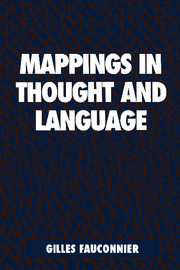Conclusion
Published online by Cambridge University Press: 05 June 2012
Summary
Perhaps the most surprising aspect of the organization of language and thought is the fundamental unity of the cognitive operations that serve to construct the simple meanings of everyday life, the commonsense reasoning of our daily existence, the more elaborate discussions and arguments in which we engage, and the superficially far more complex scientific theories and artistic and literary productions that entire cultures develop over the course of time. We have seen that the simplest meanings are in fact not simple at all. They rely on remarkable cognitive mapping capacities, immense arrays of intricately prestructured knowledge, and exceptional on-line creativity. They also rely on the impressive, and poorly understood, human ability to resolve massive underspecification at lightning speeds.
The cognitive operations focused on in this book have included crossspace mapping, access and spreading principles, space tracking by shifting viewpoint and focus, matching, structure projection, and conceptual blending. We are not conscious of performing these operations when we speak, think, and listen. Everything takes place very fast, and only the words themselves and the global emergence of meaning are accessible to consciousness. At other levels of thought, such as science, poetry, or rhetoric, there may be more awareness of some of the operations; we may consciously perceive an analogy, a metaphor, or a metonymy. Yet typically, even then, most of the efficient cognitive processes are hidden from view, and their overall structure is seldom directly apprehended.
- Type
- Chapter
- Information
- Mappings in Thought and Language , pp. 187 - 192Publisher: Cambridge University PressPrint publication year: 1997

